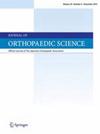下肢振动对全髋关节置换术后髋部疼痛和功能的影响:随机对照试验
IF 1.5
4区 医学
Q3 ORTHOPEDICS
引用次数: 0
摘要
背景:振动滚筒是减轻肌肉酸痛和改善受损肌肉功能的有效工具。然而,它在减轻全髋关节置换术后髋部疼痛和改善功能方面的功效尚不明确。我们在一项随机对照临床试验中研究了使用振动滚筒进行下肢振动对全髋关节置换术后髋部疼痛和功能的影响:30名计划接受全髋关节置换术的患者被随机分配到振动组和对照组。振动组患者使用振动滚筒进行下肢振动。对照组患者使用热敷袋进行假治疗。除常规物理治疗外,患者在术后第 1-7 天每天进行 10 分钟的两种干预。主要结果是使用视觉模拟量表测量髋部疼痛强度。次要结果是疼痛-压力阈值、血清肌酸激酶和 C 反应蛋白水平。我们还对身体功能进行了评估,包括哈里斯髋关节评分、髋关节活动范围、肌肉力量、步速和定时起立行走测试。采用分割图设计方差分析法比较了干预措施对各组结果测量的影响:经过一周的干预和三周的随访,与对照组相比,振动组在运动引起的髋关节疼痛、大腿外侧痛压阈值和血清肌酸激酶方面均有显著改善(P = 0.006、0.003 和 0.012)。在身体机能方面,各组之间没有发现明显的统计学差异:结论:全髋关节置换术后使用振动滚筒进行下肢振动是一种有效的干预措施,可减轻运动引起的髋关节疼痛并改善血清肌酸激酶,但对身体机能没有协同作用。本文章由计算机程序翻译,如有差异,请以英文原文为准。
Effects of lower limb vibration on hip pain and function after total hip arthroplasty: A randomized controlled trial
Background
A vibration roller is an effective tool for reducing muscle soreness and improving damaged muscle function. However, its efficacy in reducing hip pain and improving function after total hip arthroplasty is unclear. We investigated the effect of lower limb vibration using a vibration roller on postoperative hip pain and function after total hip arthroplasty in a randomized controlled clinical trial.
Methods
Thirty patients scheduled for total hip arthroplasty were randomly assigned to vibration and control groups. The patients in the vibration group performed lower limb vibration using a vibration roller. The patients in the control group performed sham therapy using a hot pack. Patients performed both interventions for 10 min daily on postoperative days 1–7, in addition to regular physical therapy. Primary outcome was hip pain intensity as measured using a visual analog scale. Secondary outcomes were pain-pressure threshold and serum creatine kinase and C-reactive protein levels. We also assessed physical functions, including the Harris Hip Score, range of motion of the hip joint, muscle strength, gait velocity, and timed up-and-go test. The effects of the interventions on outcome measurements in the groups were compared using a split-plot design variance analysis.
Results
After one week of the intervention and three weeks of follow-up, the vibration group showed statistically significant improvement in the exercise-induced hip pain, pain-pressure threshold of lateral thigh, and serum creatine kinase compared to the control group (p = 0.006, 0.003, and 0.012, respectively). No statistically significant differences were found between the groups regarding the physical functions.
Conclusions
Lower limb vibration using a vibration roller after total hip arthroplasty was an effective intervention to reduce exercise-induced hip pain and improve serum creatine kinase, but there was no synergistic effect on the physical functions.
求助全文
通过发布文献求助,成功后即可免费获取论文全文。
去求助
来源期刊

Journal of Orthopaedic Science
医学-整形外科
CiteScore
3.00
自引率
0.00%
发文量
290
审稿时长
90 days
期刊介绍:
The Journal of Orthopaedic Science is the official peer-reviewed journal of the Japanese Orthopaedic Association. The journal publishes the latest researches and topical debates in all fields of clinical and experimental orthopaedics, including musculoskeletal medicine, sports medicine, locomotive syndrome, trauma, paediatrics, oncology and biomaterials, as well as basic researches.
 求助内容:
求助内容: 应助结果提醒方式:
应助结果提醒方式:


